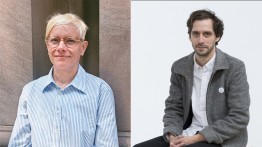Meet the Deans: Adriana Farmiga and Yuri Masnyj
POSTED ON: October 2, 2024

This fall, Dean Adriana Farmiga and Assistant Dean Yuri Masnyj, who graduated from Cooper’s School of Art in 1996 and ’98 respectively, have known each other since their student days when they were both members of the Art Student Council. They each fought vocally and vigorously against tuition and, as Farmiga puts it, the two have been connected to Cooper so long that “our familiarity with the institution is second nature.” They are excited to be working together as the school continues making progress toward the 10-Year Plan to Return to Full-Tuition Scholarships, and they see many opportunities to address true equity on campus. They recently reflected on their history, their practice, and their plans for the School of Art this year.
You two have known each other for years. What does that shared history bring to your current collaboration?
Yuri: Between the two of us, our collective institutional memory is useful in how we approach decisions in our work. This is equally true for the handmade quality of Cooper: when we look at the curriculum, the shops, or the facilities, we remember who made them. We saw the circumstances of how they came to be. It's this personal connection to the college that affirms our commitment to it.
Adriana: As collaborators, we complement each other well! We both want to roll our sleeves up and dive right in, but we also realize that it’s important to pace ourselves. There’s so much that we want to do, but there’s also still so much to learn, even for the two of us, who are essentially architectural details of this institution at this point.
What role does being a working artist play in teaching?
Adriana: For me, teaching and practice are closely intertwined, especially after nearly two decades of teaching. They inform each other. As artists, we are constantly negotiating the edges of our practices. The same negotiation happens in the classroom, so there is a very generative feedback loop. We are both interdisciplinary artists who can move fluidly through disciplines because of our investment in discipline itself, whether that’s sculpture, or drawing, or so on.
Yuri: As educators, we believe that it's important to be in practice. The time in our studios is when we get close to the process of making and where the conditions of being an artist are acutely felt. These experiences inform the decisions we make as teachers and as deans. Cooper has a tradition of artists educating artists. It’s a place where connections are made through the communal experience of working in community.
What are some of the major projects of the coming year?
Yuri: To start with, we’re mounting an exhibition in the Stuyvesant-Fish House of Haitian-born, Brooklyn-based artist Paul Gardère, a 1967 graduate. Overall, we’re looking to restore a sense of community that was lost during Covid, including on the administrative side bringing faculty meetings back in person. We want to hold more community-centric gatherings and are engaging with alumni to bring the school’s workings and updates to our extended community.
Adriana: We want to do the preliminary work on our five-year strategic plan and meet with all the school’s constituents to better understand what is needed as we move forward towards and beyond the return to free. Our goal is to further cultivate an environment where students, faculty, and staff can do their best work. And of course, we want to continue bringing compelling speakers and programming to the Great Hall, continuing to activate it as one of New York’s great civic spaces.




